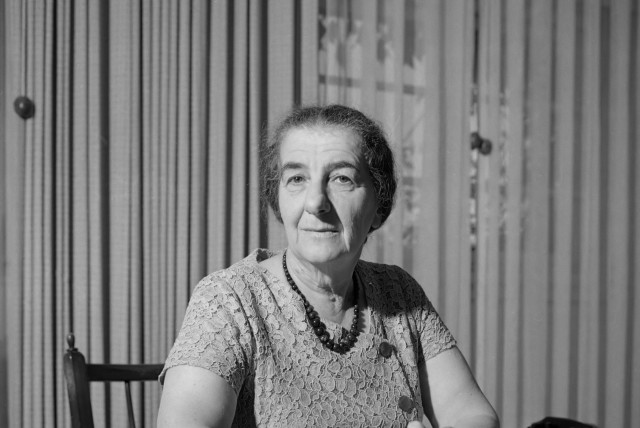'The Only Woman in the Room': A feminist biography of Golda Meir - review

Most books about Golda Meir in English project her as a celebrity, “the grandmother of the nation,” and gloss over the politics. This book has chosen another direction.
Pnina Lahav’s book The Only Woman in the Room: Golda Meir and Her Path to Power tells Golda’s story through “the lens of gender.”
When Israel’s Declaration of Independence was signed, only two of the 37 signatories were women – Rachel Kagan and Golda Meir. This is symbolic of the profound difficulty that women faced in the ideologically male-centered world that existed in the days of early Zionism, in which women were generally expected to remain at home and forget about a career.
Lahav, an American law professor, acts as both narrator and interpreter, coloring Meir’s career from the palette of having to deal with the hard men of politics.
The unknown real, authentic personal life of Golda Meir
Growing up in the poverty of socialist Milwaukee, where many Jews were forced to go to work on Shabbat to provide for their families (like many children of Jewish immigrants across the country), Meir became imbued with the idea of revolutionary change – and Zionism was the engine for it.
Her mother tried to impress upon her the importance of roshkosh, the Russian word for opulence. Instead, she preferred to read the speeches of Abraham Lincoln and the radical writings of Eugene V. Debs, Prince Kropotkin, and Emma Goldman. Preferring Yiddish over Hebrew, Meir was known locally as “Miss Bolsheviki.”
As the author notes, all this was omitted from her formal autobiography.
Meir’s future husband, Moshe (Morris) Myers, introduced her to the world of the English poets: Shelley, Keats, and Byron.
She dropped out of school at 15, rejected “a bourgeois way of life,” and believed that sex was not restricted to marriage; she had an abortion in Chicago.
Her determination to build Zion was also an addiction. It led to the fragmentation of her family and to separation from her husband, but it fueled her demand to be heard. Motherhood was never at the top of her agenda; she felt more at ease with the party.
Meir began by changing the operation of Kibbutz Merhavia’s kitchen, and 50 years later ended up as Israel’s prime minister.
She followed what the author has termed “a moderate feminist philosophy.” Unlike figures such as Ada Fishman Maimon, she never propagated an overtly feminist agenda. She was careful in the way she plied her politics but felt “harmony in the company of men.”
When David Ben-Gurion appointed her labor minister in March 1949, she sat beside two lovers, David Remez and Zalman Shazar, in the cabinet.
Although by the 1960s, when she was foreign minister, she had already begun to tire of the political bear-pit, Meir was brought back after Levi Eshkol’s sudden death in order to delay the succession of the factional second generation.
Lahav describes Meir as “a wizened woman with grey hair, tied in a simple bun, dressed neatly but not extravagantly, often wearing a broach or a string of pearls around her neck.”
A new generation satirized her – as in Hanoch Levin’s 1970s play Queen of the Bathtub. Her pronouncements on the nonexistence of the Palestinians, the “not nice boys” of the Black Panthers, and the “crazy women who burned their bras” did not endear her to the young.
Lahav suggests that she leaned more towards pragmatism than principle, and recognized that compromise could, at the end of the day, be harmful. She never uttered any criticism of the war in Vietnam.
The 20th century had taught Meir to embrace “catastrophic Zionism.” She was a close ally of Ben-Gurion until they fell out in the mid-1960s. He bestowed upon her “the only man in the room” epithet – which she deeply hated – and Moshe Sharett, Israel’s first foreign minister, tried to block her entry into the cabinet on the grounds that she was “too hawkish.”
This is an unusual rendition of Meir’s life and times, describing several interesting episodes such as the clandestine meeting with King Abdullah in Amman during the War of Independence. But there are also omissions.
In the chapter “The African Connection,” there is remarkably no mention of her courageous stand against apartheid, despite Afrikaaner threats against the South African Jewish community. There is no mention of her decision in 1969 to openly proclaim a campaign for Soviet Jewry’s right to emigrate to Israel – a legacy of her time as Israel’s first ambassador to the USSR. And Labor’s election victory in 1969 was not “the greatest victory of her party,” since it had only been formed the year before from other groups, and actually lost seven seats.
Most books about Meir in English project her as a celebrity, “the grandmother of the nation,” and gloss over the politics. This book has chosen another direction and rightly describes her as “the only woman in the room” in an era when the door to the room was closed to women.
This feminist biography of the only woman to become prime minister of Israel is a book which will appeal to the general reader interested in America and Israel. ■
- THE ONLY WOMAN IN THE ROOM: GOLDA MEIR AND HER PATH TO POWER
- By Pnina Lahav
- Princeton University Press
- 376 pages; $30
Jerusalem Post Store
`; document.getElementById("linkPremium").innerHTML = cont; var divWithLink = document.getElementById("premium-link"); if (divWithLink !== null && divWithLink !== 'undefined') { divWithLink.style.border = "solid 1px #cb0f3e"; divWithLink.style.textAlign = "center"; divWithLink.style.marginBottom = "15px"; divWithLink.style.marginTop = "15px"; divWithLink.style.width = "100%"; divWithLink.style.backgroundColor = "#122952"; divWithLink.style.color = "#ffffff"; divWithLink.style.lineHeight = "1.5"; } } (function (v, i) { });

